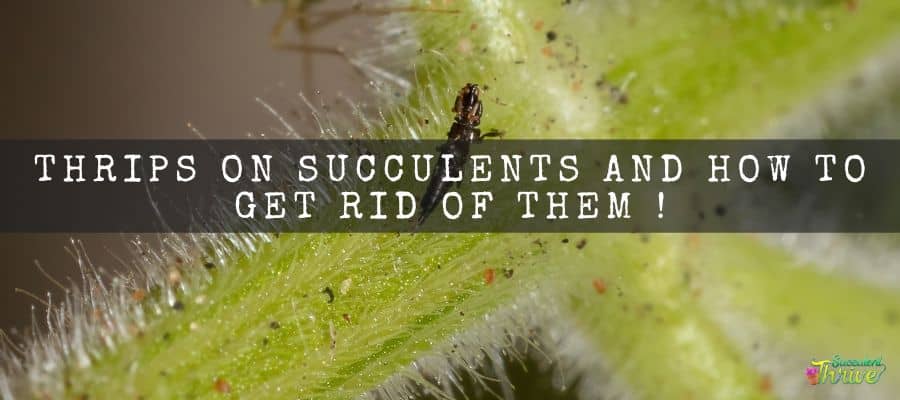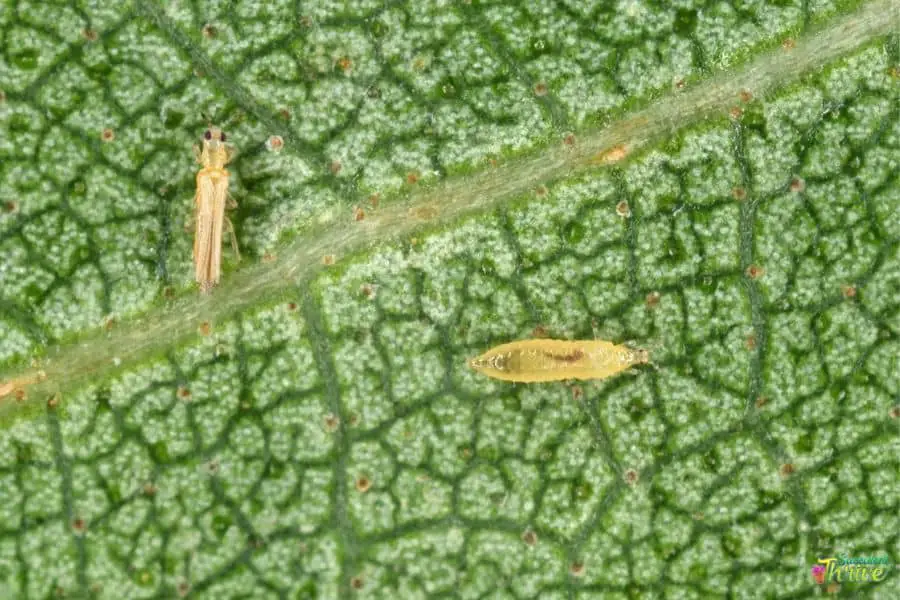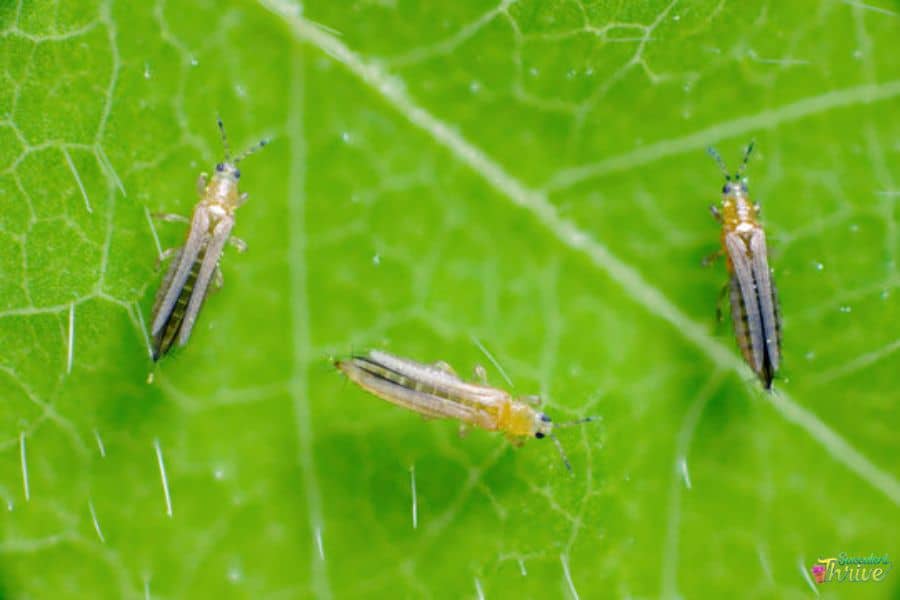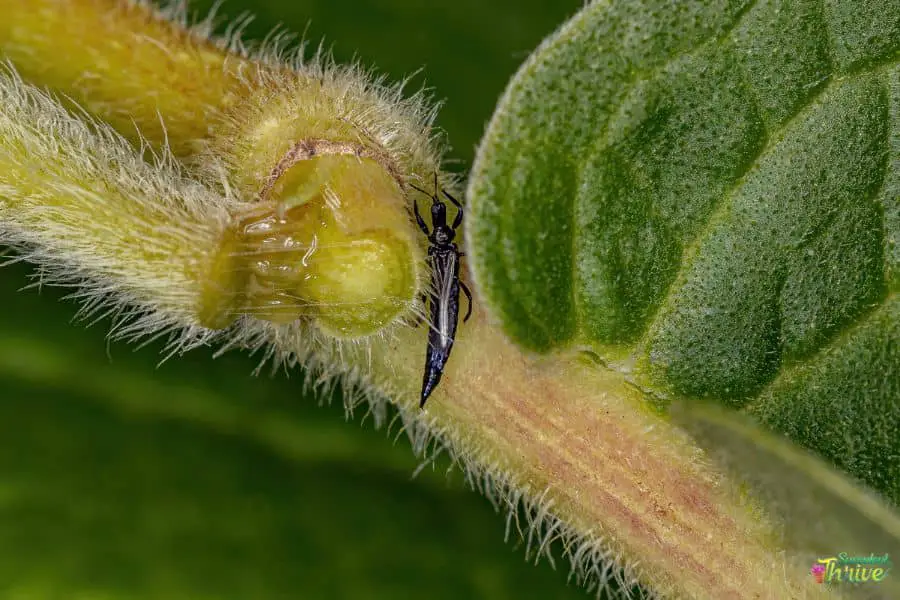When I first started succulent gardening, I had so many pest problems. One of the major problems I had was thrips on succulents. To get rid of them, I tried so many things and failed so many times. But with time and a lot of help, I learned how to get rid of these annoying creatures.
There are different thrips species, and in fact, the largest of them is the most beneficial one of them. They can guard your garden by preying on predators. On the other hand, there are other thrips that could even act as pollinators. However, if we consider the majority of the thrips, they are annoying pests that could cause some serious problems for your plants.

What are thrips?
If I describe thrips briefly, they are winged, small insect types that can be extremely irritating to all plant lovers. You could distinguish them by their bodies. Those bodies would be somewhat long and tend to take the shape of a cigar. They would typically be about 1 mm in size. In fact, it can be difficult to see them with the unaided eye.
If you spot an insect and want to confirm whether they are exactly the thrips or some other pest type, you could simply look at their wings, as they would be fringed and usually have a unique movement pattern. You could spot them either in straw color or in black. They would contain two pairs of feathery wings.
They are big fans of sucking the plant’s juice and causing problems for your crops, and there are about 6,000 thrips species that could be troublesome for you. So, if you ever come across any thrips infestations, you need to ensure that you act fast to overcome them, and I am going to address how you should act smart and get rid of them in this article.
Bit about their life cycle
Thrips are hardy survivors who can withstand harsh conditions for an extended period of time. You could ascertain this fact by examining their life cycle. The majority of the thrips species are pathogenic, and this literally means that mating is not fundamental to their reproduction process. There are several thrips species that can mate just once in their lifetime and lay eggs during their entire lifetime.
The thrips cannot be seen with the naked eye. However, thrips eggs are minuscule. They would be about 0.2 mm in size or even less than that. There are certain thrips that will even snip through the leaves for egg-laying purposes. Ultimately, they would form a gall.
It would take one or two weeks for their eggs to hatch. Thrips larvae would have a couple of metamorphoses too. In fact, they would have a somewhat shorter lifetime in their larvae stage. Thereafter, the adult stage of the thrips would appear and stay for about one or two months. This literally means they have a short life span.
They can, however, cause significant damage to your crops because they multiply rapidly. Thus, thrips are a nuisance for all the gardeners. It is noteworthy that thrips can even withstand the winter conditions, and they tend to hide in the soil during adverse winter conditions.
How to identify thrips on succulents
If you happen to brush the leaves and come across a cloud of insects, it is most likely a thrips cluster. Many gardeners can’t identify them because they are too small. So, it is very unlikely that you will identify them early. Most of the time, you could identify them during the latter part of the thrips infestation. However, if you keep monitoring your plants closely on a daily basis, you could catch them.
- First, check the leaves. Ideally, you need to look for blackened or browned discolored areas on the leaf surface. Further chances are that they may also develop silver discolorations also. In fact they may come up with line and ring patterns or develop some meandering trail of the dead tissues as well.
- Thrips would make the plant’s stem develop streaks either in black or in silver.
- Furthermore, necrotic lesions and dead spots may appear on your crops.
- Additionally, leaves may begin to look papery and dry.
- Infestations of thrips may also negatively affect plant flowering and cause flower discoloration, in addition to other effects.
- Over all, you could see a drastic change in your plants appearance and they may tend to look unhappy and weakened.
As aforesaid, it would be very challenging to distinguish the thrips. They would usually tend to occupy the areas under the leaf litter, underneath the leaves, etc. Further, they may also hide in plant buds and curled leaves. So to recognize the thrips infestation, you need to first look to see if you can spot any insect movement. In fact, once you disturb them, they tend to fly away, but not over long distances. Check again to see if you come across any Thrips waste.
Thrips would usually tend to leave dark deposits whenever they occupied an area. Some refer to this as “thrips poops.” If you could spot any black spots along with wrinkled leaves, you could confirm the fact that the plants are under attack from a thrips infestation.
Apart from that, you could inspect your plants for these insects by brushing off the leaves. Lastly, I recommend using sticky traps to identify them too. You could simply place the sticky traps, and they would identify if your crop was going through a thrips attack.

How to get rid of the Thrips
Thrips are a fragile, notorious pest species. They are widespread all over the world, and you need to make sure that you are well aware of how to overcome them if you come across any. In fact, there are several methods of getting rid of the thrips, and let’s discover what those methods are.
Using insecticidal soap
You may come across numerous insecticidal soaps, which you could use to treat them. In fact, they are all safe for all living creatures, including humans. In fact,using insecticidal soap is one of the most effective methods of overcoming the Thrips infestation. However this method would work only if your plants are wet. This literally means you need to continue adding this until you eradicate the Thrips infestation completely.
There are some insecticidal soaps that are oil-based. So, apply it with caution. In fact, oil can stay on leaves and make your plants susceptible to sunburns. So ideally, what you could do is apply it in the evening and let it stay on the affected areas overnight.
You could even make insecticidal soap on your own. Simply combine a teaspoon of real soap with a quarter of a cup of water and apply. Refrain from using detergent like dishwashing soap for this purpose. Thereafter, mix all these elements and pour them into a spray bottle. Next, you could spray them on the affected areas.
Use neem oil
Neem oil is more like a secret weapon that could be used by the gardeners. Neem oil is an oil type that you need to apply only at night. You could follow the guidelines available on the packaging when applying this. However, usually you need to dilute the neem oil and then apply it to the crops. Unless it would cause damage to your vegetation.
Introducing predators
Many people tend to introduce predators who would feed on the thrips. For example, you could introduce predators such as ladybugs and lady beetles. That said, you cannot use this method for indoor-grown plants, as nobody would love to have them in their houses. There are other insect types that you could use to do this task. However, ladybugs and lady beetles are the best. For example, lacewings and parasitic wasps would also be ideal for this task.

Other methods of getting rid of the Thrips
You may consider pruning the plants if you come across any thrips infestations. In addition to that, you could spray those areas with water spray bottles too. Besides these methods, you can apply diatomaceous earth as well. You need to simply sprinkle some of this on your plants as well as on the soil. When applied to soil, they kill the larvae as well.
Apart from that, you may also consider reflecting light on the affected places. I suggest you avoid using chemical insecticides as much as you can. Thrips are resistant to most of these chemical substances, and it is pointless to add chemical insecticides to treat thrips infestations. Further, those chemical insecticides can also be lethal to beneficial insects. Lastly, you can get rid of the infected plants themselves, as that way you could protect the other plants.
Preventive measures.
When it comes to preventive measures against the thrips infestation, the very first thing you need to keep in mind is to look after your precious succulents properly so that the plants will be less vulnerable to thrips. Once there are no favorable conditions for them, they will not bother infesting your plants.
Thrips are fond of moist environments, so ensure that you irrigate the plants properly, as it is something mandatory that you could do to protect the plants from these irritating creatures. Feed them appropriately to prevent the thrips from infesting your plants too.
Furthermore, as soon as you spot one or two thrips, you must act quickly and treat them with one of the methods listed above so that they do not cause severe consequences. Keep an eye out for any changes in appearance and be vigilant with your plants. If you spot them, try to remedy them as soon as possible.
Does hydrogen peroxide get rid of thrips?
At the end of a crop, plant detritus frequently includes thrip larvae and other life stages. Use hydrogen peroxide to treat the floor and other surfaces to prevent thrips from returning in your subsequent harvest. This substance even kills thrip pupae.

Can you wipe thrips off?
Yes, each leaf should be sprayed and then cleaned with a microfiber cloth and spray bottle.
Does water get rid of thrips?
Hard blasts of water can readily remove thrips. To get rid of thrips, you can hose off outside plants. Pay special attention to the undersides of the leaves, where the insects tend to congregate.
How long does it take for thrips to go away?
You will be thrip-free permanently within a month (or two, depending on the severity of the infestation)! However, you must be cautious—I can’t stress this enough! Whenever you water your plant, make sure the leaves and stems are healthy. even after a few months.
Why are thrips so hard to get rid of?
By essentially sucking the vitality out of plants while eating on them, they kill plants. The fact that female thrips lay their eggs in plant tissue and do not require males for reproduction is one of the reasons they are difficult to manage.
What are the plants susceptible for Thrips infestation in addition to succulents?
Plants such as apples, asparagus, avocados, beans, cabbage, carrots, citrus, cucumbers, and grapes are susceptible to thrips attacks. Apart from that, thrips may also tend to attack lettuce, onions, peas, peppers, potatoes, squash, strawberries, and tomatoes if they find favorable conditions for them. Lastly, flowering plants such as begonias, carnations, chrysanthemums, dahlias, and daylilies may also come across thrips infestations quite often.
Finally on Thrips On Succulents
Before wrapping this up, I hope you are all confident on how to deal with the thrips infestations on your succulents, how to identify the attack, and lastly, how to overcome them as well.
Read Next : The Sammons Opuntia Virus (What Do We Know About It?)
Read Next : Why Does Cactus Split? 10 Minutes Quick Read
